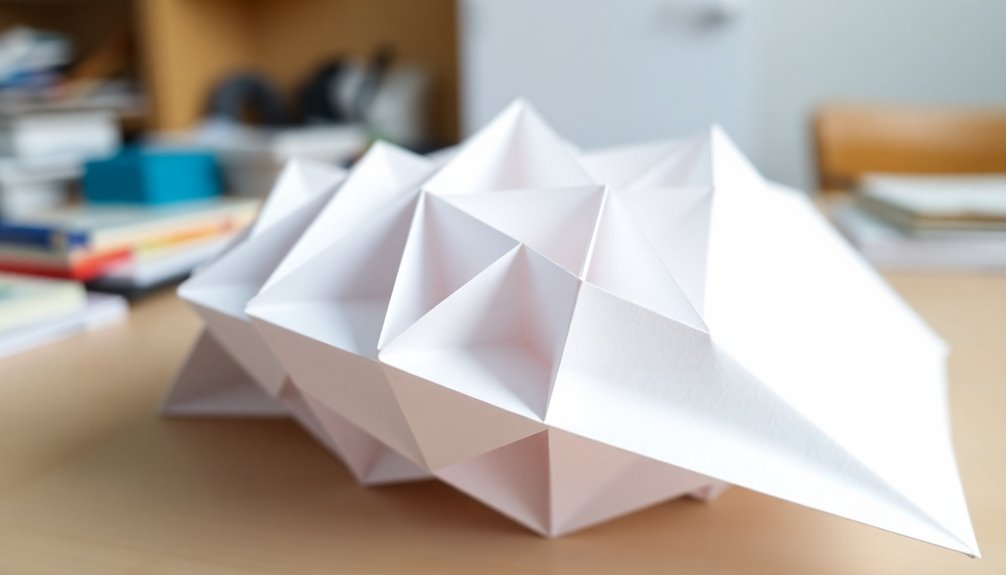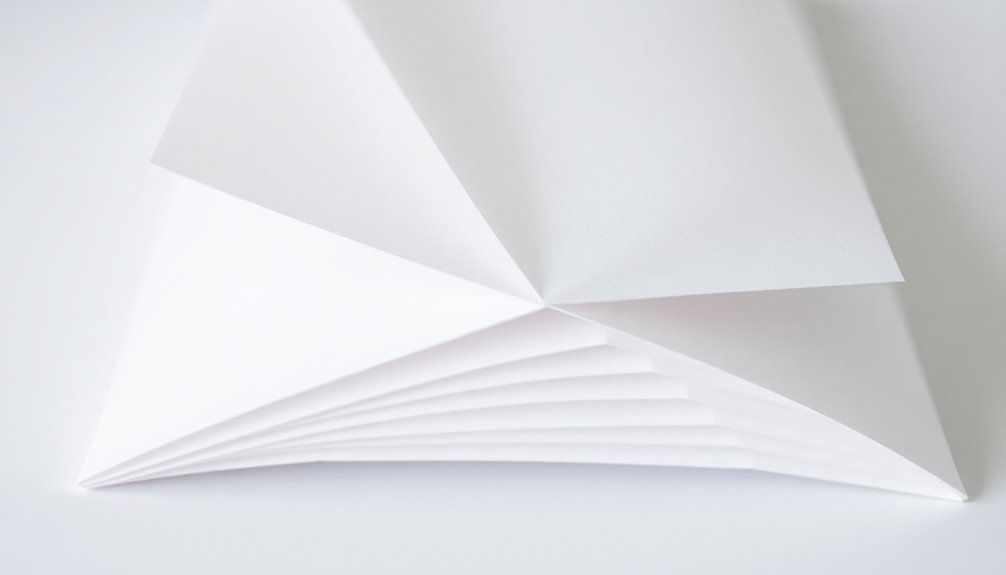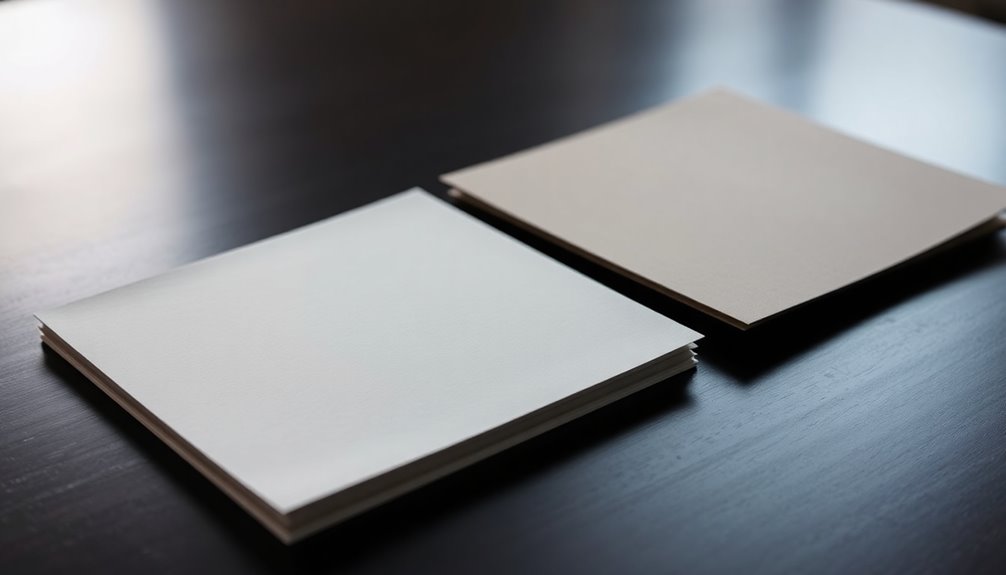You can realistically fold a piece of paper about seven times. However, in 2002, Britney Gallivan managed to fold it twelve times, challenging what many thought was possible. Each fold exponentially increases the thickness, making it harder to fold further. With specific techniques and thin, long paper, you can push the limits. In theory, folding could go as far as 50 times, reaching distances that could stretch to the sun. This fascinating exploration of paper folding reveals not just limits, but also the creative potential hidden in simple materials, opening the door to some surprising cosmic implications.
Key Takeaways
- The common belief restricts paper folding to about seven times, but this can be exceeded under specific conditions.
- Britney Gallivan successfully folded paper 12 times in 2002, showcasing the influence of paper dimensions and thickness.
- Each fold doubles the paper's thickness, following the exponential growth formula 2^n, impacting further folding capability.
- The theoretical limit suggests that 50 folds could span distances exceeding 100 million kilometers, illustrating extreme exponential growth.
- Origami techniques are applied in various fields, including architecture and robotics, demonstrating the practical applications of folding principles.
Folding Paper Defies Expectations

When it comes to folding paper, you might be surprised to learn that common beliefs can often be misleading. Many folks believe you can only fold a piece of paper in half a maximum number of times, typically seven. However, Britney Gallivan shattered this myth when she successfully folded a long, thin sheet of tissue paper 12 times back in 2002. Her impressive achievement demonstrated that the number of folds you can make depends significantly on the paper's thickness and dimensions.
Each time you fold paper, its thickness doubles, leading to exponential growth. This means that after just a few folds, the stack becomes quite hefty, making further folding increasingly challenging. In fact, theoretical calculations suggest that if you could fold a piece of paper 42 times, its thickness would surpass the distance from the Earth to the moon!
Gallivan's groundbreaking work highlighted the importance of material properties in determining how many times you can fold paper effectively. Subsequent attempts to break her record often strayed from her methods, underscoring the significance of maintaining the integrity of the folding process.
Folding Exponentially Increases Thickness

Folding paper not only defies expectations but also leads to an exponential increase in thickness with each fold. Each time you fold a piece of paper, its thickness doubles, following the formula 2^n, where n represents the number of folds. For instance, after one fold, a standard piece of paper (0.1 mm thick) becomes 0.2 mm thick. By the eighth fold, you're looking at approximately 25.6 mm of thickness.
This exponential growth in thickness quickly limits the number of folds achievable. As the thickness increases, the paper becomes structurally more resistant to further folding. Mathematically, the maximum number of folds you can achieve is determined by the ratio of the paper's width to its thickness, which can be calculated using the formula n = 0.96 ln(w/t).
Theoretically, if you could fold a piece of paper 50 times, its thickness would exceed 100 million kilometers, showcasing the dramatic impact of exponential growth on folding potential. So, while it's fun to experiment with folding, be aware that each fold dramatically increases the thickness, making further folds increasingly challenging.
Creative Origami for Structural Design

Innovative origami techniques are transforming structural design, offering lightweight yet robust solutions in architecture and engineering. By leveraging creative origami and folding principles, you can create lightweight configurations that maintain strength and versatility. The geometric progression inherent in paper folding enables designs to efficiently distribute loads, making them adaptable to dynamic environments.
Engineers have harnessed these principles to develop deployable structures, such as solar panels and emergency shelters. These designs can be compactly stored and easily expanded, providing practical solutions in various scenarios. You'll find that utilizing materials with varying thicknesses and flexibility allows for intricate folds, enhancing both the aesthetics and functionality of a structure.
Moreover, research in origami mathematics has led to innovative solutions beyond traditional architecture. In robotics and medical devices, folding mechanisms can create compact designs that expand into fully functional forms. This approach not only optimizes space but also enhances usability. Embracing creative origami in structural design opens up a world of possibilities, pushing the boundaries of what can be achieved with folding techniques and inspiring future innovations.
Theoretical Limits of Folding Paper

Understanding the limits of folding paper reveals fascinating insights into both its physical properties and mathematical principles. You might think you can fold a standard piece of paper indefinitely, but the maximum number of times you can realistically fold it is around seven. This limitation arises due to the exponential increase in thickness with each fold.
Britney Gallivan demonstrated that to fold paper 12 times, you need a long, thin sheet to overcome the limits imposed by thickness and width. Theoretically, if you were to fold a 0.003-inch thick paper 42 times, it could reach a staggering height of over 273,280 miles—far exceeding the distance from Earth to the moon.
Gallivan's mathematical formulas show that the number of folds (n) depends on the width (w) and thickness (t) of the paper, expressed as n = 0.96 ln(w/t). This formula underscores the theoretical limits of folding paper and how quickly thickness can grow. In fact, after just 50 folds, the thickness could reach the sun, illustrating the astonishing implications of exponential growth in folding scenarios.
Origami in Architectural Design

As architects explore new ways to optimize space and efficiency, origami principles have emerged as a powerful tool in design. By applying folding techniques, you can create innovative designs that maximize functionality while minimizing material usage. These origami-inspired architectural designs lead to lightweight structures, enhancing both aesthetics and sustainability.
Utilizing origami concepts, architects develop dynamic facades and roof systems that adapt to environmental conditions, significantly improving energy efficiency. This adaptability not only addresses climate challenges but also contributes to overall sustainability in modern architecture. Moreover, research into origami has resulted in the creation of self-deploying structures, which simplify transportation and assembly, making them ideal for temporary architecture and disaster relief shelters.
Notable examples illustrate the impact of origami in architectural design. The National Art Center in Tokyo showcases a stunning folding roof design, while Kengo Kuma's "Origami House" highlights the seamless integration of art and engineering. As you delve deeper into the world of origami, you'll find it's not just about folding paper; it's about reshaping our approach to building and design for a more sustainable future.
Folding Paper Reaches Cosmic Sizes

Origami's influence on architectural design showcases how folding techniques can transform physical spaces, but the wonders of paper folding extend far beyond buildings. When you think about folding a piece of paper, it's easy to underestimate the potential. Each time you fold paper in half, you double its thickness, leading to astonishing results. For instance, if you managed to fold a sheet 30 times, it could theoretically reach the moon!
Now, consider this: if you could fold that same single piece of paper an incredible 103 times, it would stretch across the observable universe, which is about 93 billion light-years wide. This phenomenon illustrates the concept of exponential growth, as 12 folds result in a thickness of over 4 kilometers.
It's mind-boggling to think that folding paper beyond just 42 times could yield a thickness surpassing the distance between Earth and the sun. The world record for paper folding is a testament to this concept, demonstrating that even mundane materials can lead to cosmic dimensions when folded repeatedly. So, the next time you fold paper, remember the vast possibilities hidden within those folds.
Frequently Asked Questions
Is It True You Can Only Fold Paper 7 Times?
You might've heard that you can only fold paper seven times, but that's not entirely true. While a standard sheet reaches its limits around then due to its thickness, it's possible to fold a longer, thinner sheet many more times. In 2002, a record-breaking 12 folds were achieved using a 4,000-foot-long tissue paper. So, if you experiment with different paper types and sizes, you could discover surprising results!
Can You Fold a Paper 8 Times in Mythbusters?
In the Mythbusters episode, you'll find that they couldn't fold a standard sheet of paper eight times. They tested various papers and techniques, but the thickness of standard printer paper limited them to about seven folds. However, they did demonstrate that using a long strip of paper could potentially allow for more folds. So, while it's tough to fold paper eight times, it's not entirely impossible under specific conditions.
Is Folding Paper 42 Times Possible?
Folding paper 42 times isn't practically possible. Each fold doubles the thickness, and by the 42nd fold, the paper would be incredibly thick—over 4.4 trillion times its original thickness! You'd face immense challenges just trying to manipulate it. The exponential growth in thickness makes it more of a theoretical concept than a real-life scenario. So, while it's fascinating to think about, you won't be folding paper that many times anytime soon.
What Happens if You Fold Paper 103 Times?
If you fold paper 103 times, you'd create an unimaginable thickness, theoretically reaching the size of the observable Universe, which spans about 93 billion light years. Each fold doubles the thickness, leading to exponential growth that makes it physically impossible with standard materials. Even just 30 folds could get you to the moon, illustrating how quickly the size escalates. Folding paper this many times challenges your perception of scale and growth.










